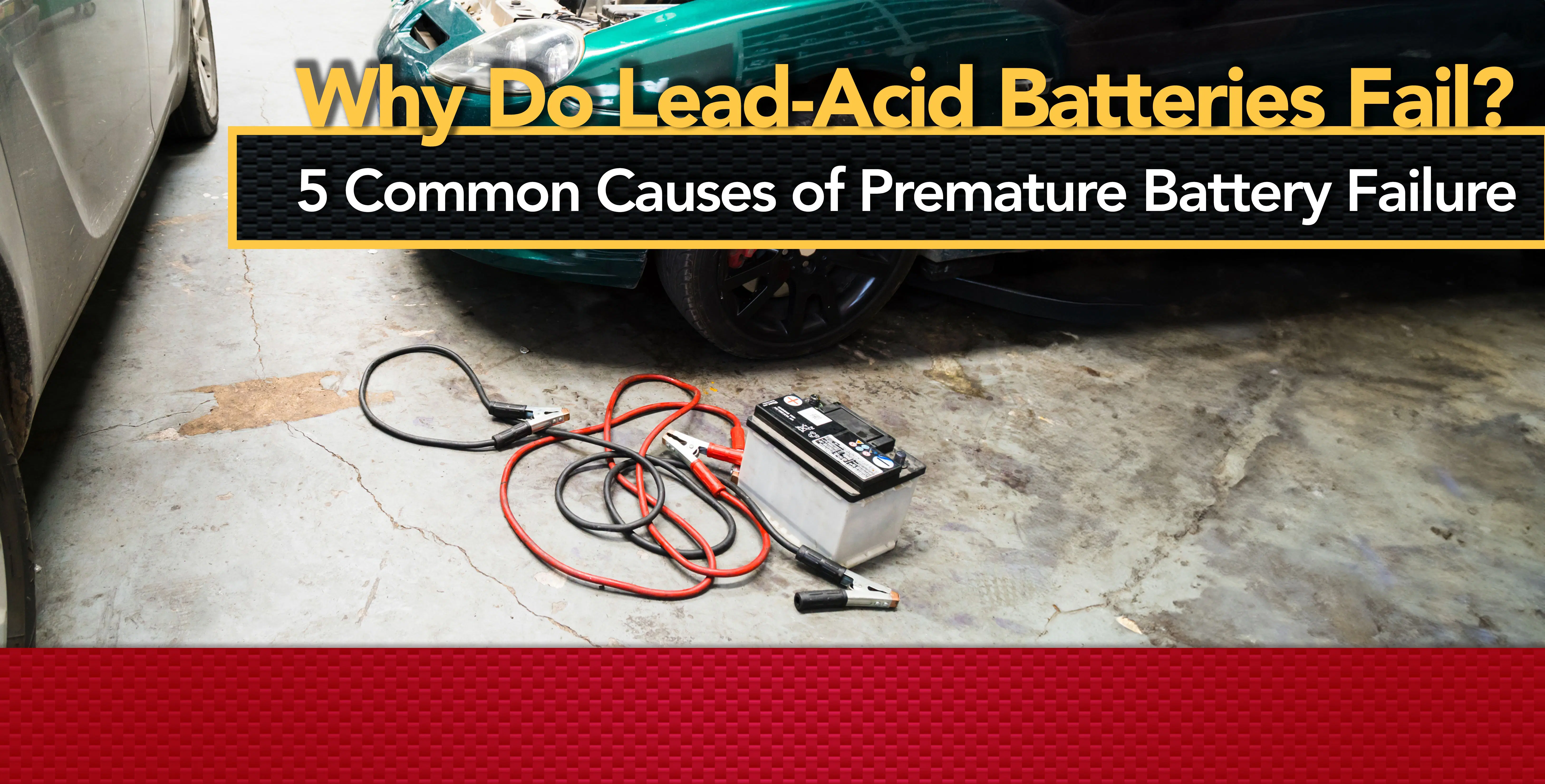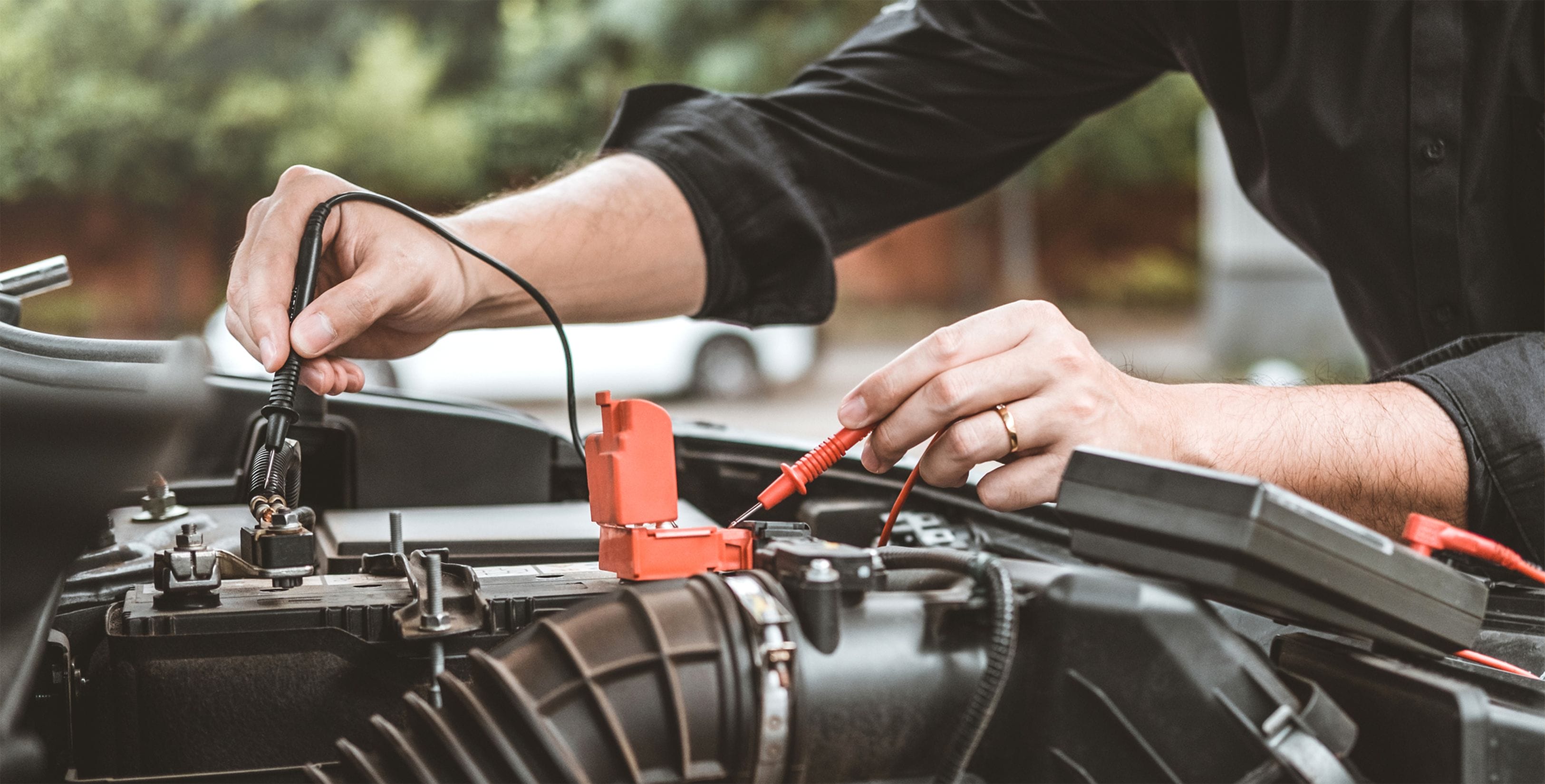
According to Battery University, “Battery malfunction is seldom caused by a factory defect.” In fact, factory defects are responsible for less than 7% of battery failures. So why do batteries fail? In most cases, it comes down to driving habits, environmental conditions and natural wear and tear.
In this blog post, we will look at what causes battery failure and how to get the most life out of your battery.
5 Common Causes of Premature Battery Failure
The click of a dead battery is never a welcome sound, especially if your battery should have plenty of life left. Check out these common causes of lead-acid battery failure and what you can do about it.
 1. Undercharging
1. Undercharging
Keeping a battery at a low charge or not allowing it to charge enough is a major cause of premature battery failure. According to Battery University, keeping a battery operating at a low charge (below 80%) can lead to stratification, where the electrolyte “concentrates on the bottom, causing the upper half of the cell to be acid-poor.” This can affect the overall performance of the battery and eventually lead to failure.
Undercharging can also lead to sulfation, a condition in which lead sulfate deposits form on the surface of a battery’s lead plates. These can become large crystals that impact performance and cause battery death.
A consistently undercharged battery also leads to corrosion on the terminals and a gradual decrease in the ability to hold a full charge. You may notice that your battery has a harder time starting, especially in cold weather, or the electrical systems begin to fail or malfunction.
The most common cause of undercharged car batteries is frequent short trips. This is evident in the habits of Japanese drivers, where battery failure is the largest complaint among new car owners. Most Japanese drivers drive about eight miles per day in city traffic. According to Battery University, “North America may be shielded from these battery problems, in part because of long-distance driving.”
 2. Irregular Use
2. Irregular Use
Batteries naturally lose power when left sitting idle. This is called self-discharge. The self-discharge rate for a lead-acid battery is about 4% per month. This number may be compounded by parasitic draw from the electronics in your vehicle. The longer your battery sits, the more it will discharge, leaving it open to sulfation and stratification.
ADAC reports the number one cause of car breakdowns is battery failure, and that lack of use is a major culprit.
“At the height of the [COVID-19] pandemic in 2020, the frequency of battery breakdowns rose sharply because the cars were often not driven at all or only very little. The explanation: A battery suffers less from wear and tear during operation than from wear and tear when not in use.”
If you don’t drive your car frequently, make sure the battery is charged. You can do this by taking it out for drives more frequently or removing the battery and connecting it to a battery tender or trickle charger.
 3. Extreme Temperatures
3. Extreme Temperatures
Batteries work best in temperate climates. Extreme cold and extreme heat can both lead to shortened lifespans and premature failure. While your car may be harder to start in sub-zero winters, heat is actually the true enemy of the car battery.
According to Consumer Reports (CR), “Hot summer temps drive up the heat under the hood and accelerate the onset of battery failure.”
One of the main culprits in premature battery failure is positive grid corrosion, which is a natural occurrence over time. However, it is accelerated by operating in an extremely hot climate. Positive grid corrosion can also be caused by overcharging.
When CR tested car batteries in simulated summer conditions, they found that AGM batteries performed markedly better than conventional lead-acid batteries. If you’re worried about heat sapping your battery life, you may want to consider swapping your FLA for an AGM, which traditionally has a longer lifespan and performs better in extreme conditions — including high temperatures. Just make sure to check with your owner’s manual to ensure compatibility.
 4. Vibration
4. Vibration
Vibration is another major reason for battery failure. Excessive vibration can cause the battery’s internal plates to shift and become damaged, leading to a breakdown in the battery’s structure and causing short circuits within the battery. Vibration also accelerates corrosion, which leads to premature failure.
Off-road vehicles or those that are frequently driven on rough terrain are more susceptible to vibration damage. The plates in AGMs are tightly packed and rigidly mounted, and will withstand shock and vibration better than a standard battery, making them a good fit for more rugged use.
 5. Age and Regular Wear
5. Age and Regular Wear
Even if you practice perfect battery maintenance, all batteries have a shelf life. For conventional flooded lead-acid batteries, you can expect three to five years of life with good care. AGM batteries last about seven years. Their design and robust construction make them ideal for all-terrain vehicles and those with increased electrical loads, like start-stop technology.
Frequently Asked Questions
Why do AGM batteries fail?
AGM batteries are lead-acid batteries that are sealed, non-spillable and maintenance-free. They use very fine fiberglass mats between thicker lead plates to trap the electrolyte. They’re generally more robust than FLAs, but the causes of premature failure are similar. The most common culprits include:
- Improper charging (overcharging or undercharging)
- Extreme high or low temperatures that can reduce lifespan
- Physical damage caused by vibration, shock or impact
- Age and normal wear
Why do batteries fail in cold weather?
Your vehicle may be harder to start on a cold day because extreme cold weather causes the battery to work harder to provide the power necessary to crank the engine. The electrochemical reaction that actually generates a battery's power is slowed when the temperatures drop below freezing.
A battery that has not been maintained properly can fail when temperatures hit 20 degrees Fahrenheit.
Why do batteries fail in hot weather?
Extreme heat can wreak havoc on a car battery. Not only does heat evaporate the battery’s electrolyte, but it can speed up corrosion and weaken the battery’s function, shortening its lifespan. Cleaning, maintaining and properly charging your battery will help guard against death by overheating.
If possible, park in a garage or shaded area during the hottest part of the day.
Can improper storage drain my battery?
All lead-acid batteries will naturally self-discharge, which can result in a loss of capacity from sulfation. The rate of self-discharge is most influenced by the temperature of the battery’s electrolyte and the chemistry of the plates.
If you’re storing your lead-acid battery for an extended period of time, store it in a cool, dry place outside the vehicle. It’s also a good idea to hook it up to a battery tender or trickle charger to ensure an even charge.
Maintenance for a Long Battery Life
Understanding why batteries fail allows you to take proactive steps to properly care for and store your batteries, ensuring a long life at maximum power. Remember, a little maintenance goes a long way toward keeping your battery in top condition, no matter where it takes you.







